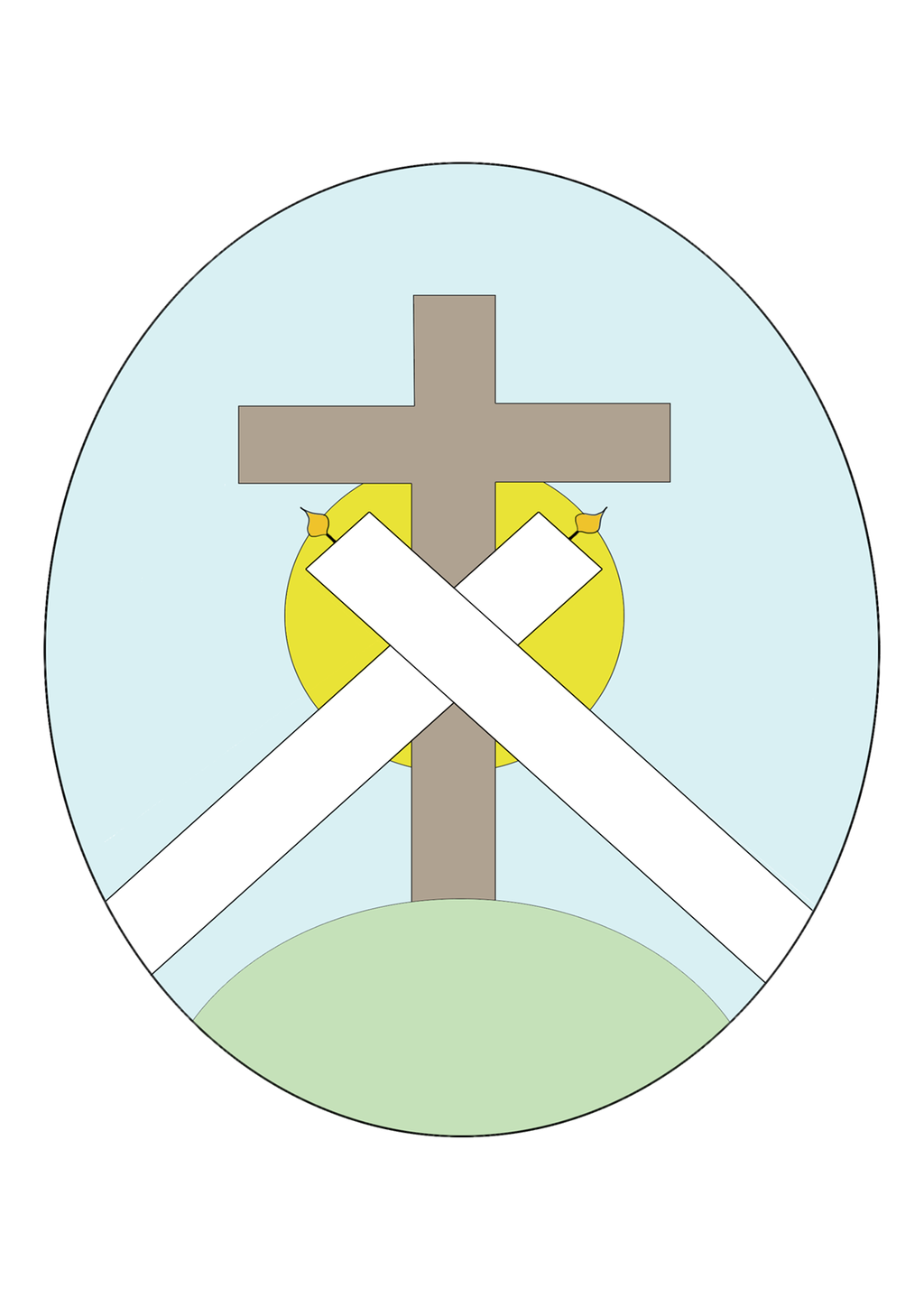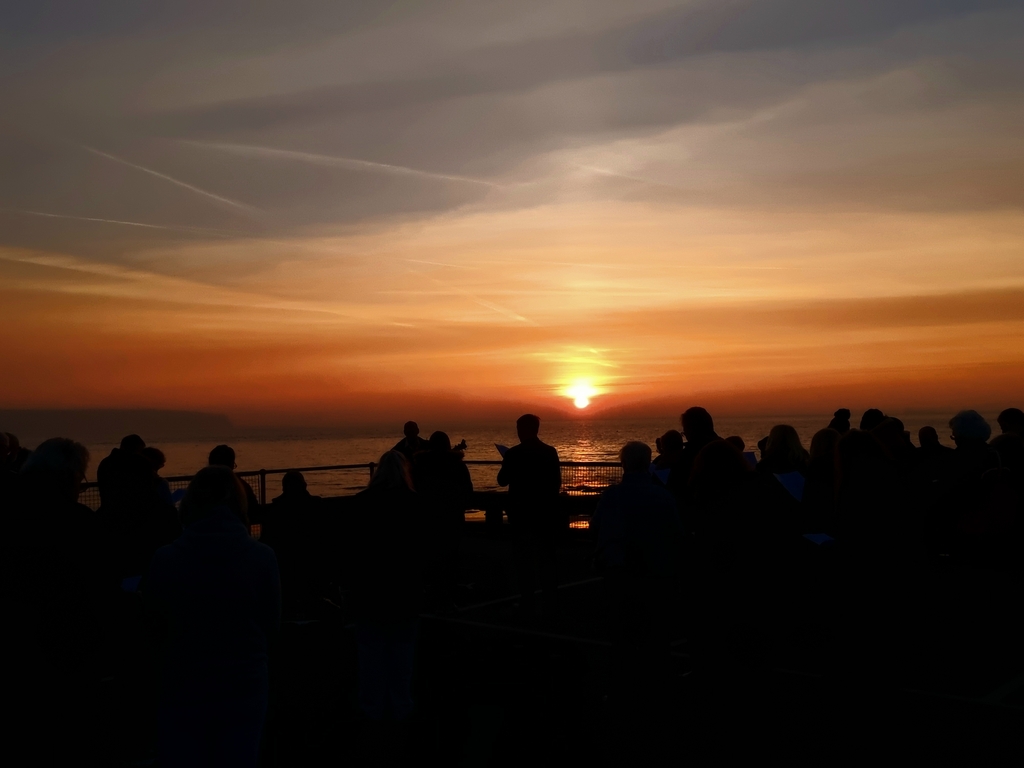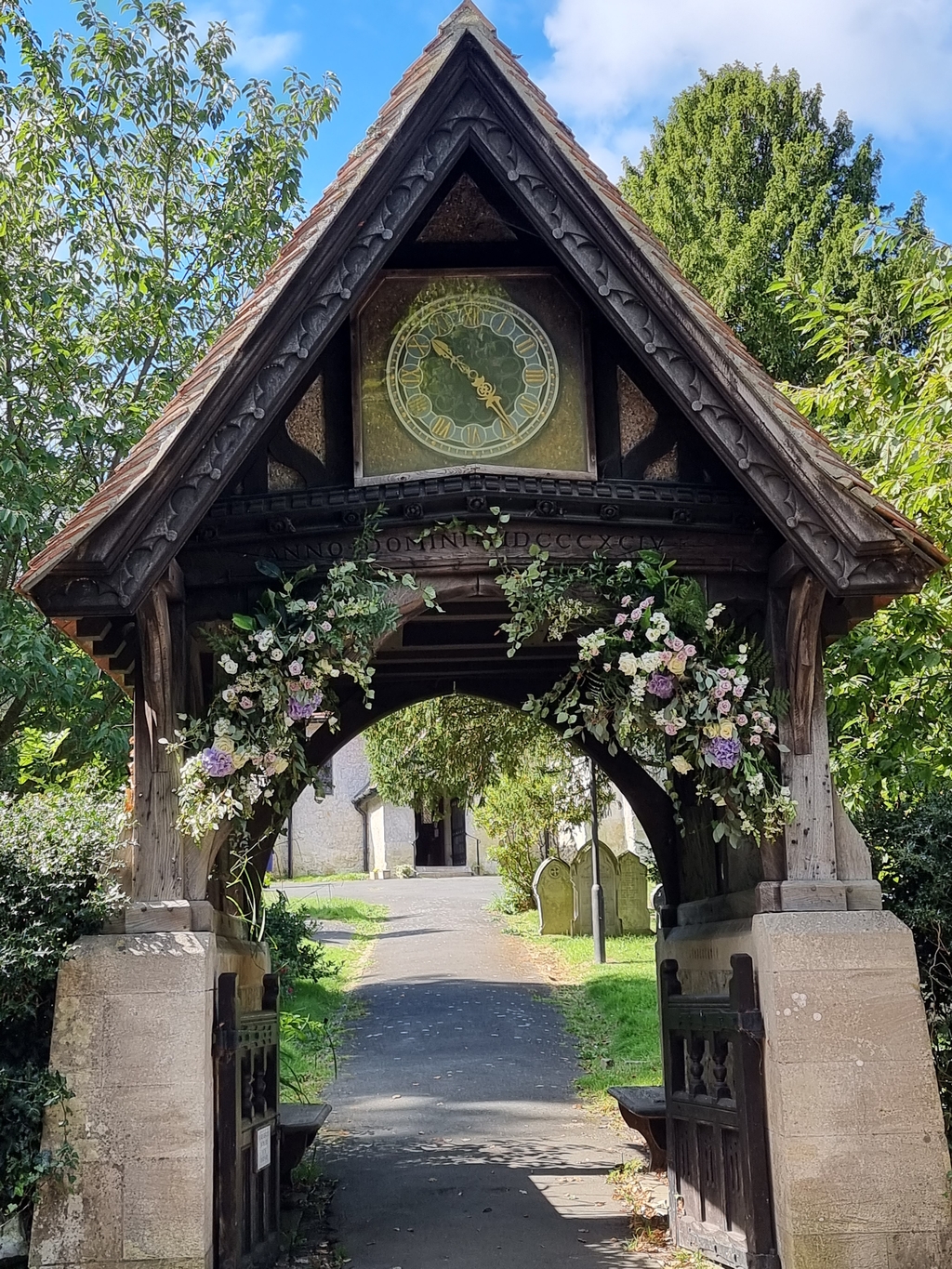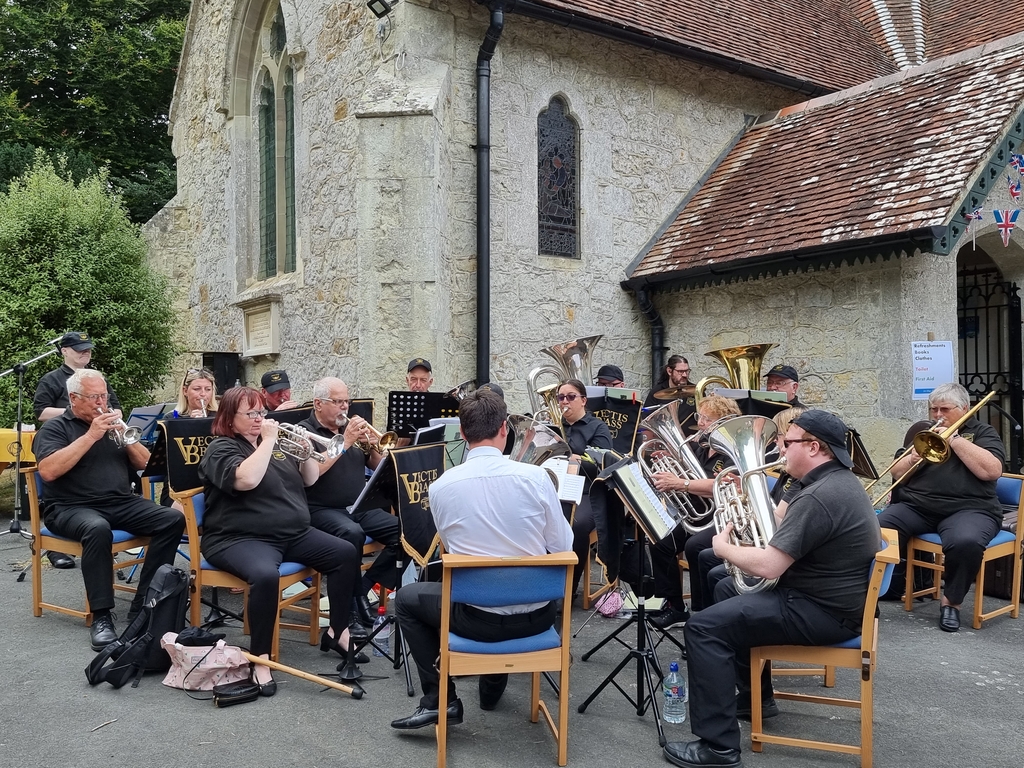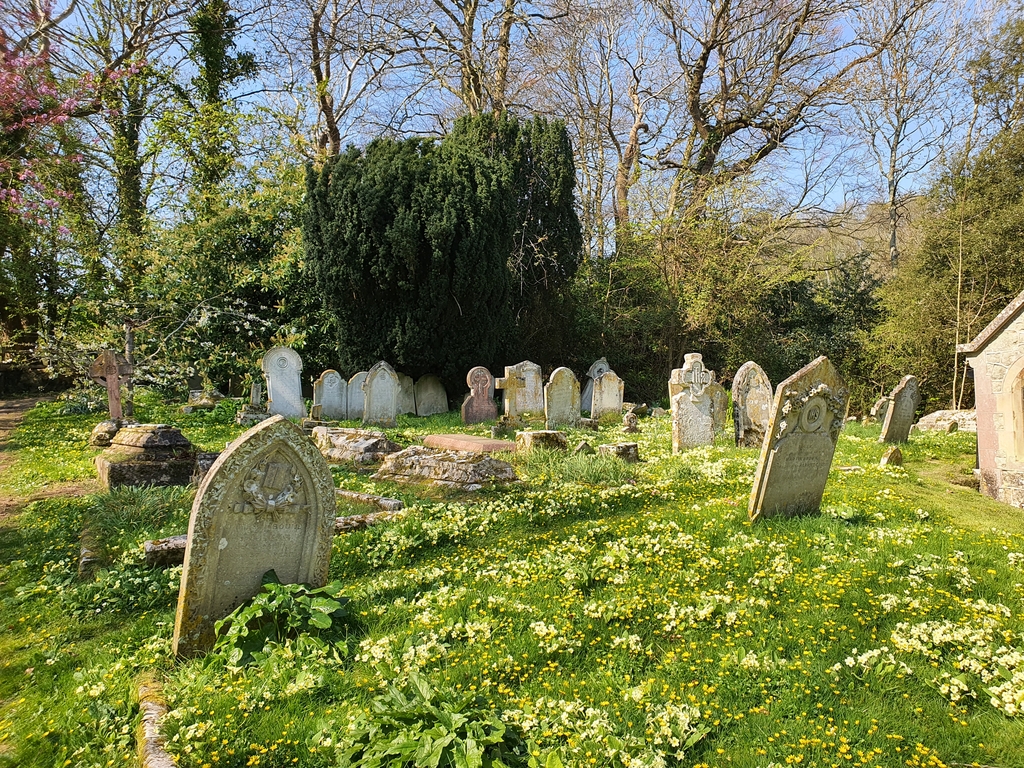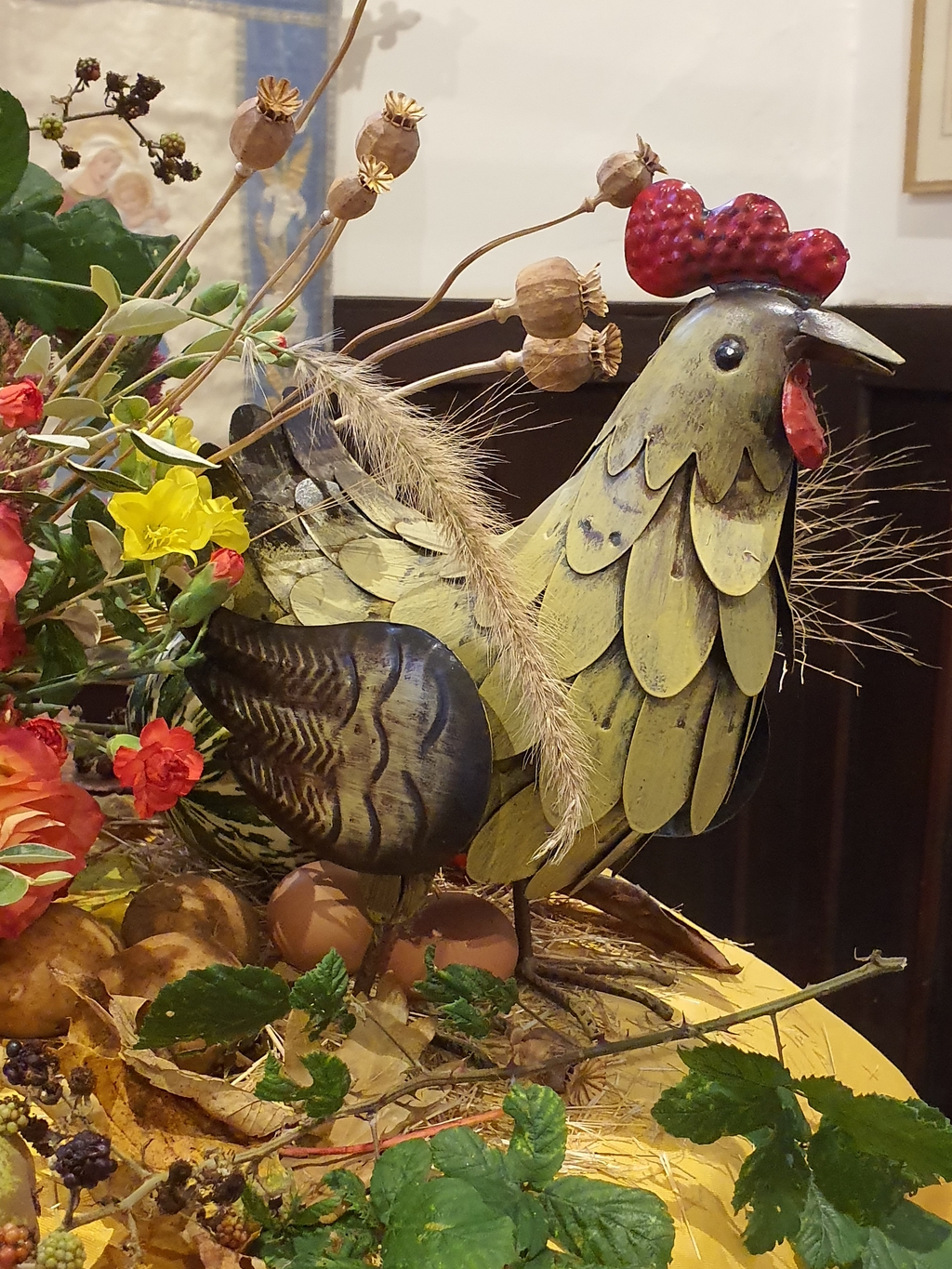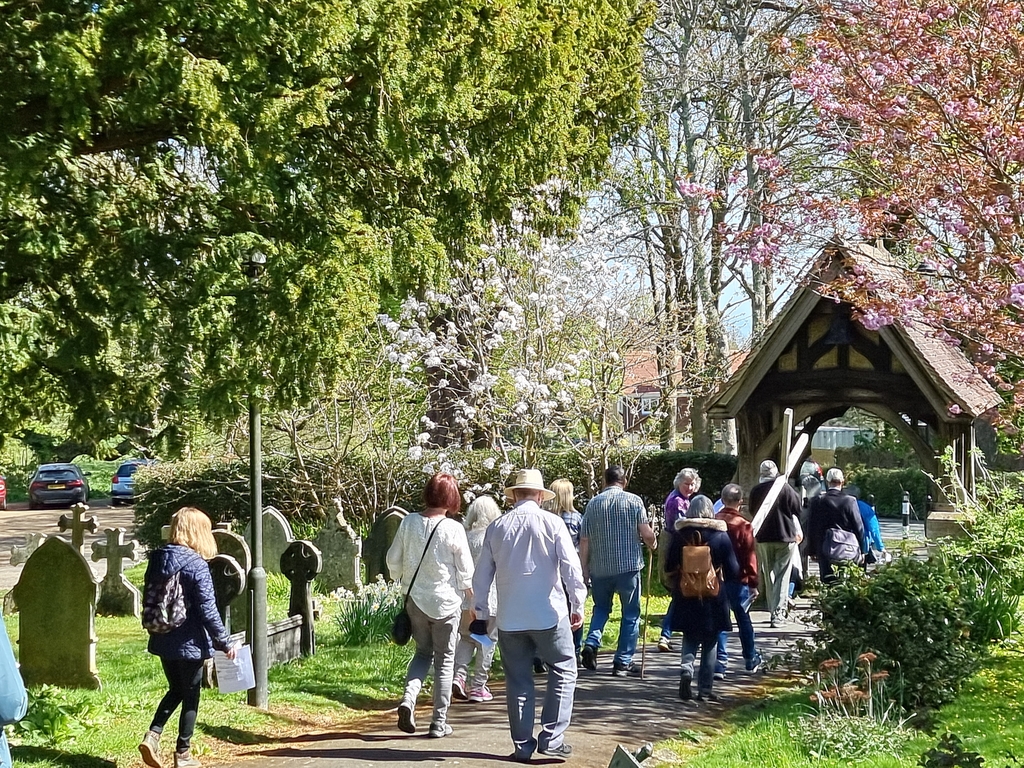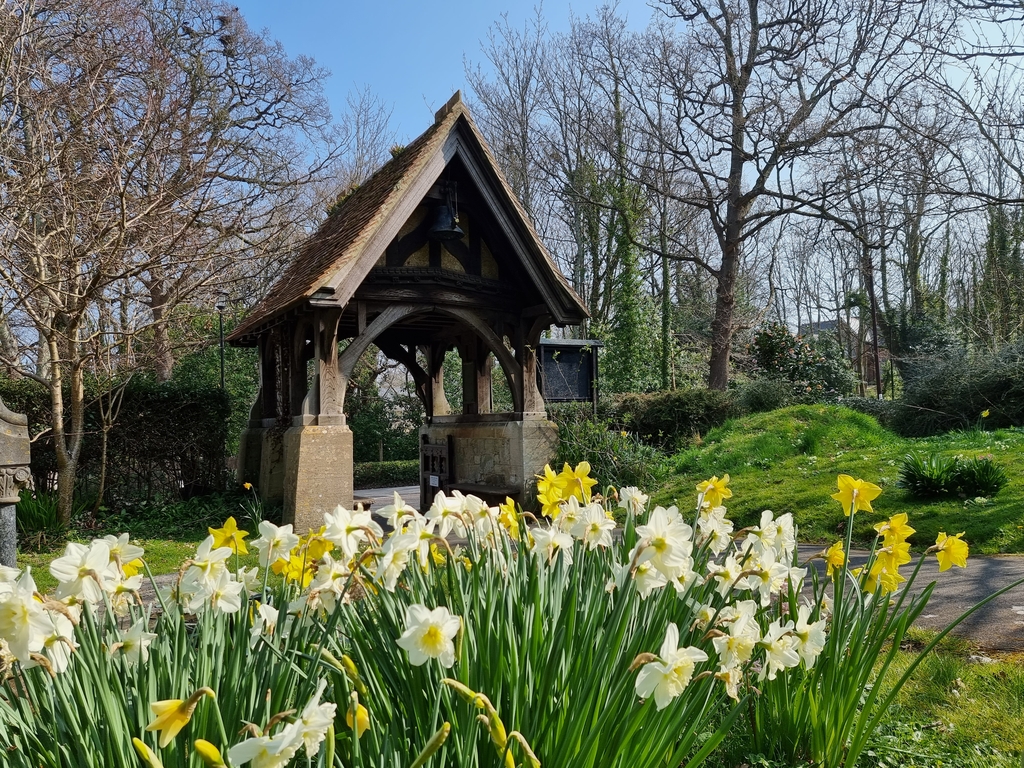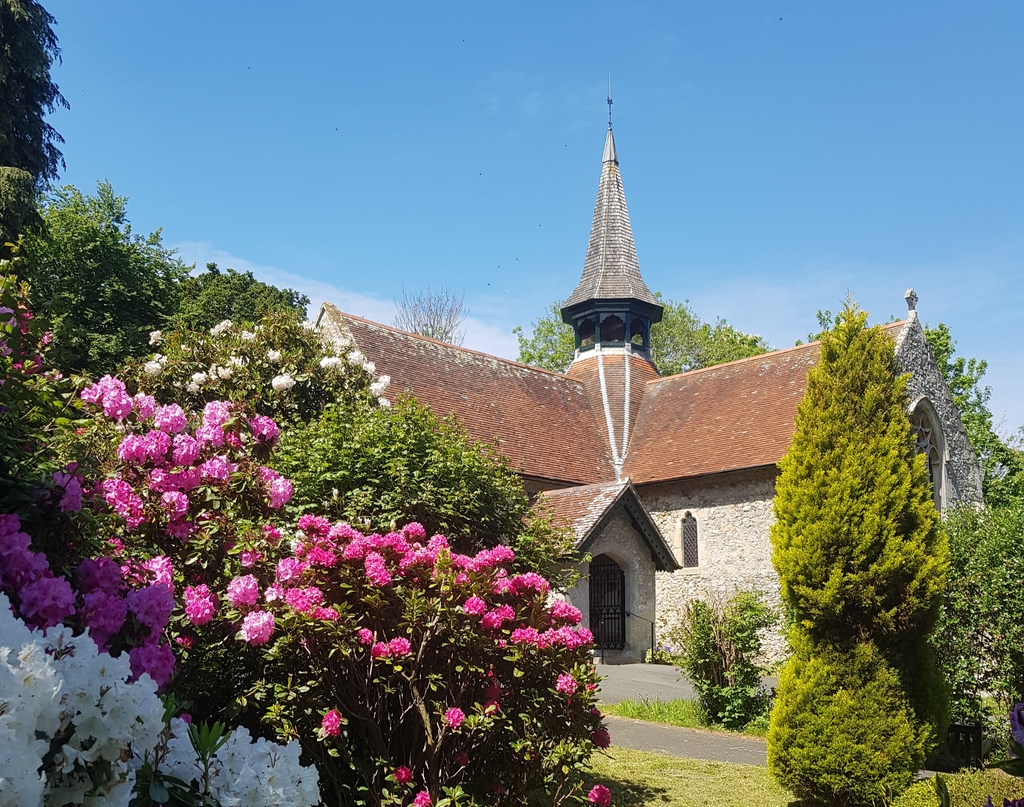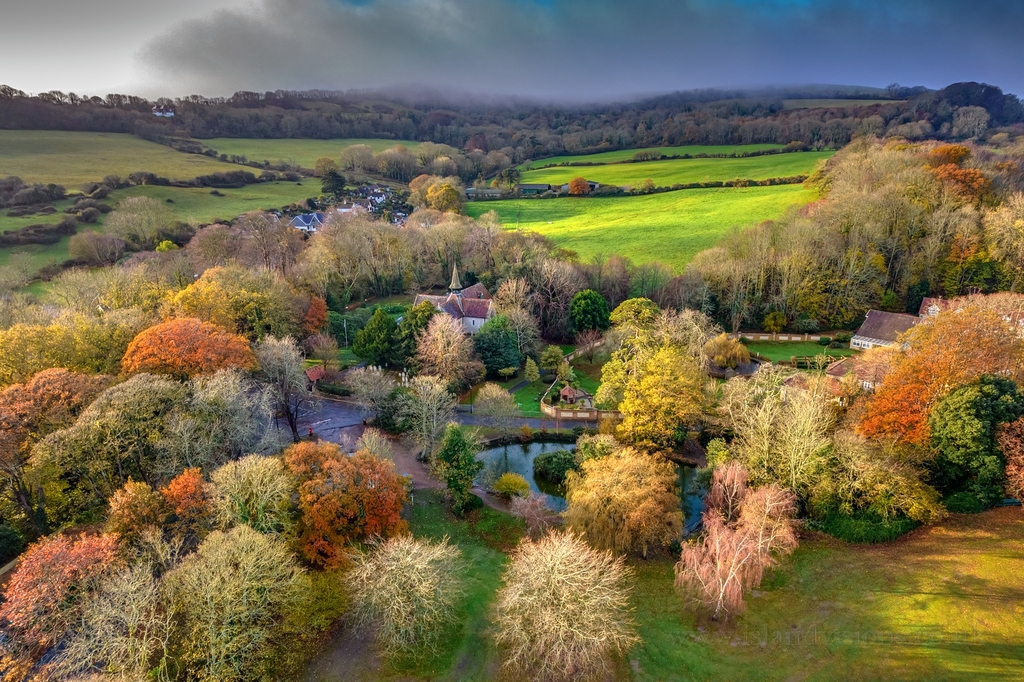The chapel of St. Blasé (Blays, Blasius) or St. John at Shenklyn
Inception and the early centuries: 11th to 15th
Pre-conquest, there are no records to help us, but the Domesday survey in 1086 gives the first mention of Shanklin, held by Joscelin FitzAzor. It is a fact that a church, at neither Brading nor St. Helens, finds a place in the return made to the Conqueror.
The first chapel was built here in the twelfth century by Geoffrey de Lisle for the use of his family and tenants at Shanklin and for the tenants of Ralph de Glamorgan in Landguard and Sandown. Several writers state that one of the Lisle family, who then held the Manor, built it in the reign of King Stephen (1135 - 54).
An agreement in Latin, dated about 1160 (translated by Sir John Oglander of Nunwell in 1632) was made under the authority of Cardinal Beaufort, Bishop of Winchester, and brother of King Stephen. This agreement was between Simon of Beverley, parson of Brading, Geoffrey of the Isle (de Insula) and William Stower and concerned the establishment and endowment of a chapel in Shanklin, owing fealty to Brading as the mother church. The agreement is signed by Ralph, Archdeacon of Winton; Roger, Archdeacon of Surrey; Robert de Lyra, William Russell and Ralph Bearne. The dedication was to St. John the Baptist; though in 1367 it is referred to in the Bishops' Registers as "The Chapel of St. Blays of Shanklyng".
On this evidence, it is safe to say that the church of St. Blasius (or St. John the Baptist) dates from the twelfth century. From the very beginning, the alternative dedications were recorded, and through the centuries that followed the connections with Brading and Bonchurch were also to vary.
Throughout the Hundred Years War (1337 - 1453), the Island was subject to French incursions and frequent alarms. At this time, the "Church at Shentlyn" furnished one archer, for the defence of the Island. However, in quieter times, Cardinal Beaufort's "Valor, Beneficium in Insula Vecta" deemed the Chapel of St. John of Sentling to have no value on account of its insignificance.
By the fourteenth century, the records (Calendar of Patent Rolls) indicate that St. Blaise was the saint of the Lisle family sanctuary within the church. When the chapel was first presented for institution, the King (Edward III) as custodian of the land had the living in his gift.
Through these centuries, and later, the chapel may have looked very much like the Old Church at Bonchurch. It was entered by what is now the door between the Parish Room (old Baptistery) and the nave, the hollowed steps testifying to the years of use. On the jamb of the door can still faintly be seen, with the scratched outlines of simple crosses, a crusader's cross. Was it carved there by the follower of Richard the Lionheart who brought the dedication of St. Blasius back with him to Shanklin? Perhaps...
The chapel from the sixteenth to the eighteenth centuries
In the intervening centuries, the chapel of St. Blasius remained under the patronage of the Lords of the Manor. It was connected to Bonchurch by various appointments of Rector and Clerk, although in 1519 the Rector was instituted on the same day but separately to Bonchurch and Shanklin, and in 1558 the chapel is referred to as "the free chapel of St. Blaze with the parish of Brading".
There is, however, no record of annexation to either Bonchurch or Brading and the next institutions to Bonchurch omit St. Blasius, until in 1570 the Clerk, Richard Cook, was instituted to the Parish Church of Bonchurch and Shanklin. When he died in 1604, the next presentation was to the Rectory of Bonchurch with the chapel of Shanklin. The inhabitants of Shanklin were buried at Brading "as of right" until the first interment in the churchyard in 1857. Ministers continued to be buried at Brading until the mid-18th century. Before that only the Lords of the Manor and their families were buried at Shanklin.
It is in the eighteenth century that the parish registers record the first baptism, the first marriage and the first recorded burial of a rector:
1724 William, son of David and Elizabeth Proctor was baptised on Christmas Eve.
1754 John Robin of the parish of Shorwell was married to Mary Weeks of Shanklin on May 1st.
1766 Reverend Cornelius Norwood, Rector 1763 - 6 was buried on January 16th.
In 1788, the chapel is recorded as still maintained by the patrons, William Hill and Sarah Popham.
The Tomkins engraving dates from the late eighteenth century (1794 or 1796) and shows the simple chapel with the bellcote at the west end, with entry through the south wall porch.
It seem that the Dissolution of the Monasteries, the Civil War, Protectorate and Restoration, the 1688 revolution and other major upheavals in national affairs had only incidental effects on the Shanklin Chapel, though the arrival of the Silksted chest may have been a result of the Civil War, and tradition says that Charles I, whilst a prisoner at Carisbrooke Castle, was allowed to ride under escort to visit the Manor and chapel where he received Communion in the church porch.
The early nineteenth century: changes became necessary
In the early years of the nineteenth century, the Shanklin chapel proceeded much as it had done for most of its existence, though the recorded baptisms and marriages were more frequent. In 1831, Shanklin was a small coastal settlement of 355 people: so far, even the well-documented visits of John Keats had made little difference to the place. The church baptism registers record children of fishermen, coastguards and customs officers. It is probable that the fishermen had other, less legitimate, occupations, which accounts for the Preventative men. The invasion fears of the time of the Napoleonic Wars had gone and a resident of Shanklin in earlier centuries would have noticed few changes had he been able to return.
However, the need for definitions became pressing as is shown by the record of disagreements between the incumbent (the Reverend Justly Hill) and the patrons (his cousins).
In 1816 - "the present incumbent about seven years after his appointment adopted measures to set up a Rectory (parish) at Shanklin took virtual possession of the freehold by locking up the key after Divine service and carrying it away to his own house demanded parochial Rights and the Appointment of a churchwarden failing in the last point the key was placed in neutral Hands for some Years and accessible, for repairs by the Patron who also buried and placed a Hatchment in the interior " (Original punctuation retained)
In 1836 - "Alterations for increase of accommodation having been made which did not please the incumbent from that date. He has assumed the sole possession of the Chapel put a Door to the porch and kept it locked so as to exclude the Patron, from internal repairs needful to an ancient and dilapidated building. He has also procured a Sermon to be preached - by a colonial Bishop to raise money for improved accommodations and has signified to the Agent of the Patron /who has been very anxious and is still willing to effect them at his own charge/ that he intends to rearrange a lot out the old chapel under sanction of the ordinary for whom he is preparing a proposal for this interference.”
There followed a request for clarification:
"Is the benefice of Shanklin Chapel or a Rectorial Parish Church.
Has it by frequent though desultory insertion in the same presentation with the Rectory of Bonchurch, where there is a separate church and Distinct Parish, become presentative and so amassed/ although by no formal deed or arrangement/ as to demand union therewith in future presentations or may it be separately disposed by Donation. If presentative or otherwise in whom is the freehold?
If in the Patron how is this right to be resumed in course of the Law? How exercised, and maintained against the usurpation of the Incumbent or Ordinary. By whom if a free chapel as admitted by Bishop Waynflete when instituting on lapses by whom is the chapel visitable if process to enforce repairs become needful - the Lord Chancellor or the Ordinary?”
It is clear that the easygoing ways, when no one seemed particularly concerned about areas of power, were becoming insufficient!
The mid-nineteenth century
Signs of changes to come began to appear (rather like the spring flowers, first just one bloom, then a few, and more - until everything seems to bloom at once). An early indicator from the Church records was the baptism in 1838 of John Daish, Hotel Keeper. The gathering momentum of the changes is confirmed by two other entries: 1864 records the baptism of the child of a railway worker and 1865 that of a child of the stationmaster.
The railway came in 1864, the result of the growing popularity of Shanklin and a cause of further growth of the town. By then the transformation of the church had happened, the work starting in 1852. The original, probably aisle less, chapel had been lengthened westward, the north and south transepts were added and, with the roof being raised some five to six feet, a bell turret constructed at the intersection. The date, 1859, can be seen carved on one of the cross beams of the octagonal tower, if you stand by the Rector's stall and look upward. The Reverend George Southouse guided the enlargement. Fittingly, the window of Christ with the twelve apostles is a memorial to him, and at the west end of the nave is the organ loft, added in his time, the organ replacing the flute and clarinet accompaniment of earlier years. In Thomas Hardy's "Under the Greenwood Tree", we are given a wonderful picture of church music when organs were rare, except for major churches.
Much of the church as we now see it dates from this time of major rebuilding. The baptistery was built then, retaining the original south door (way) with its worn steps showing that people had gone down into the old church. Two symmetrical pointed arches separate the baptistery from the south transept and until 1997, the font was in this room. Perhaps the most important recognition of the change in church and village was that, under the patronal name of John the Baptist, the church became a parish church in its own right in 1853. Shortly afterwards the first person was interred in the churchyard.
ST. BLASIUS - AND SOME MYSTERIES
Many visitors ask, "Who is St. Blasius?" as few English churches were dedicated to him. This question can be answered, but if they continue by asking, "And why is this church dedicated to him?" the answers become hedged about with "possibly", "probably" or "it could be that..."
To deal with the easier question first: St. Blasius, or Blaise, was the young bishop of Sebaste, in Armenia (now in Turkey) in the time of the Roman Emperor Licinius, in the early fourth century. It was a time of persecution of the Christians and, his whereabouts known only to his congregation, Blasius had to take refuge outside the city walls, in a cave in the forest. Here he ministered to sick or injured creatures that he found, while a reward was offered for his capture. The forest animals lost their fear and made their way to him. An unfortunate return for Blasius' goodness was that the tracks of the visiting animals led hunters to discover his hiding place; they took him back to Sebaste so that they could claim the reward.
As he was being taken to prison, a woman brought him her son, who was choking to death with a fishbone in his throat. Blasius freed the bone and saved the boy. As thanks, the woman brought him food and candles in prison as he awaited trial. Blasius was tortured by being torn with sharpened wool-combs, before being beheaded. These features of his story caused his later adoption as the patron saint of wool combers and of sore throats. He was also the patron saint of animals, until he was superseded by St. Francis of Assisi in the 15th century.
Quite how St. Blasius came to be the patronal saint of this small church in Shanklin is a matter of speculation, though some facts are known.
Knowledge about him came to England as a result of the crusades. When Richard the Lionheart, on a crusade in 1192, was shipwrecked on an island off the coast near Regusa, (the present day Dubrovnik in Croatia), he wished to build a church to offer thanks for being saved. However Bernard, Archbishop of Regusa, persuaded him to give the money towards the rebuilding of the cathedral in the city, dedicated to St. Mary and St. Blasius. Because Archbishop Bernard was extremely unpopular in Regusa, the citizens managed to send him to England with Richard when the king returned to his kingdom, and on Richard's death in 1199 Bernard remained at the court of King John. When the Pope appointed another Archbishop of Regusa, Bernard was left without position or income and had, perforce, to accept demotion to the position of Bishop of the then undesirable diocese of Carlisle, a post unfilled for some years as it was a wild and disputed borderland. Clearly, Bernard, ex-Archbishop and the new Bishop of Carlisle brought the Balkan St. Blasius to Northern England.
A puzzle and a guess
Tradition has it that one of the family at Shanklin Manor went on the crusades and is believed to have carved the crusader's cross on the original doorpost to the chapel (this cross can still be seen in the stone). He might, if he was a member of King Richard's retinue, have heard of the saint at Regusa, or from Archbishop Bernard.
A question of dedication
If the chapel had been consistently dedicated to St. Blasius since the twelfth century, we might consider the puzzle of the dedication virtually solved. But the twelfth century dedication by Geoffrey de lnsula (the family later became Lisle) of the manorial chapel was not to St. Blasius, but to St. John the Baptist. Mention of St. Blasius/St. Blaise is made through the centuries, though at the time of the major rebuilding in 1852, and as late as 1890, the church was still known as St. John's. The dedication to St. Blasius must therefore be a revival, perhaps of the dedication of a chantry altar within the chapel. There is no known record of the change or of the reasons for it. Some of the mystery remains.
Some other Mysteries
The Renaissance Chest
One of the church's treasures, situated in the former Baptistery now the Parish Room, is a beautiful heavy oak chest, inscribed "Dom Prius Thomas Silksted, Prior from the year of Our Lord 1512".
Thomas Silksted was Prior of St. Swithin's, Winchester, known to be a patron of sculpture in wood, and that part of the chest's provenance is not in doubt. The small mystery is how it comes to be in Shanklin Old Church.
As usual, there are conflicting suggestions. Perhaps it arrived at the time of the English Civil War in the mid-seventeenth century, sent filled with some Winchester Cathedral treasures for safekeeping by the Royalist manorial family. When the treasures were returned, the chest may have remained. Alternatively, it may have been a domestic chest (surely an unusually fine one) which might have passed by gift, bequest or sale to other hands when Prior Thomas died.
The Crypt
Access to the burial crypt under the chancel (part of the 12th century chapel) now seems to be impossible, and perhaps the dust of long dead members of the Lisle, Denys and Popham families should be left undisturbed.
Perhaps only idle curiosity leads to the wish to know more about this inaccessible place, but examination of the stonework that must be there might throw interesting light on the date of the earliest chapel on the site. 11th century or 13th? Perhaps 18th or completely altered in the mid-Victorian refurbishment?
Steps leading to a bricked up wall have recently been uncovered, under the pews to one side of the original doorway. One day repairs may need to be made, but until then this intriguingly inviolate space will guard its secrets - or lack of them.
The Hatchments
There are three funeral hatchments displayed in the church, one over the door to the parish room and two in the chancel over the choir stalls. At one time it was believed that the one over the door dated from Stuart times but after it was cleaned and restored (thanks to Mrs. Anne Springman, great-great niece of Francis White-Popham, the last resident Lord of the Manor, and the direct descendant of Geoffrey de Lisle) it was found to be the funeral hatchment for King George II. How this hatchment came to St. Blasius Church remains a mystery.
The two hatchments in the chancel belong to the Popham family. The one on the right hand side facing the altar (also cleaned and restored thanks to Mrs. Springman) bears the arms of John Popham, of Shanklin and Newchurch, married to Grace Shapleigh of Newcourt Deven, who died in 1763. His memorial slab can be seen partly concealed by the kneeler at the altar rail. The other bears the arms of John Popham of Kitehill and Shanklin, married to Mary Perry of Kitehill, who died in 1816.
There are also two wooden panels hanging on the end wall of the South transept depicting the arms of King Charles I and Charles, Prince of Wales (later Charles II). These are not funeral hatchments but rather arms that hung in all churches during the reign of Charles I. During the Commonwealth, following the English Civil War, most of these panels were destroyed by Parliament. The Lord of the Manor at the time was a Royalist and hid the panels until after the Restoration, when they were reinstated in the church. Perhaps these, with the Georgian hatchment and the wooden coat of arms of William III above the clergy vestry door, are evidence of the loyalties of the Manor during those reigns.
Some recorded griefs and moving memorials
Inside St. Blasius Church, there are more than the usual number of memorials to children and young people who died before their time.
A natural place for visitors to stand is in the centre, under the tower. At their feet on the chancel floor they are sure to notice the white marble slabs, diagonally inscribed to the memory of three Popham children. All were the issue of John Popham who died in 1763.
Elizabeth, aged 13, was the daughter of his first wife Grace. The other two were children of his second wife, Elizabeth. They died aged 5 months and 10 months respectively. The simple recording of these deaths is perhaps more moving for leaving the grief it represents to be imagined.
On the wall of the chancel is a graceful marble tablet paying tribute to another Popham child, twelve years old Sarah Shapleigh Popham who died in 1808. The inscription's moderation increases our awareness of love and grief
"This small tribute of regard and gratitude to the memory of a most excellent child is given by her affectionate parents."
What more could her parents give their lost daughter?
Two later records of girls who died young are in the form of stained glass windows, near to the south transept door. These both date from 1861. One shows a little girl tenderly guarded by an angel and bears the inscription, "To the memory of little Kate". The other, in a strongly similar style, shows Jairus' daughter being raised by our Lord. It is dedicated to Charlotte Wilhelmina Walker, who died on the 8th January 1861, aged 19. The watching figures lead us to remember the parents who chose the inscription, "She is not dead, but sleepeth" ... a more comforting sentiment with which to contemplate these sad memorials.
Other windows
The main window in the South transept is a memorial window given in memory of Francis White-Popham who died in February 1894, by his widow, Margaret. This depicts the resurrection appearance of Jesus to Mary Magdalene. The lozenge shaped window at the top bears the arms of the Popham family. It bears, scratched on it, the name of the local glass maker who constructed it - Wm. D Grounsell - painter - Shanklin July 5 1872, and pre-dates the rest of the window.
The East window, over the altar, depicts the angel telling the shepherds of the birth of Jesus. We have no record of when this was put in place or who had it erected.
The window in the North transept depicts Jesus and his disciples at the Sea of Galilee. It is unusual in that not even Jesus is shown with a halo. This window was erected in 1881 in memory of the Rev. George Southouse, rector of the parish from 1853 - 1880.
The window in the parish room shows the parable of the sower. This was placed by the family of Captain Charles Douglas- Hamilton R.N. in 1911.
There was a round Rose window installed at the West end of the church when it was extended in 1852, but this was obscured when the two-manual organ by Forster and Andrews was installed in 1874, and can only now be seen from outside the church. Seven of the original thirteen panels have been replaced by plain glass.
The engraved glass panel depicting St. Blasius in the small window in the North transept is in memory of the Rev. Canon Edmund Dana, Rector of the parish from 1949 - 1962, and who was a regular worshipper at the church after his retirement from ministry in 1981. The window has been designed and produced by a local glassmaker, Martin Evans of Glory Art Glass, Sandown, who also engraved the shields in the parish room windows.
Other features of the Church Interior
The Entrance
The visitor coming into the church by the main South door will immediately notice the font, the pulpit and the cruciform shape of the building. The shape dates from the mid-19th century rebuilding when the North and South transepts were added with the Baptistery (now the Parish Room), and the old chapel was elongated to the West, where the organ loft is now.
The Font
Some twentieth century guidebooks have referred to the font as "modern" but in the vellum register containing Records of baptism, from 1724 (mentioned in Mr. Hewson's memorandum of the neighbourhood) the date is given as 1697. Certainly, the stonemasons who moved the font when the Baptistery was transformed into the Parish Room said that the stonework was much older than the Victorian mortar, which had been used to hold it together. Part old, part modern, massive and plain, it now stands opposite the entrance in the South transept - a symbol of entry into the Church by baptism.
The Pulpit
The impressive pulpit is raised in the South East corner of the transept and is clearly seen from all parts of the church. It was made in the mid-19th century at the time of the rebuilding and refurbishment, using older (probably 17th century) panels of strong Flemish or German carving.
Shown in the five panels, in order from the steps, are:
1. St. Peter with his keys and book.
2. St. Thomas, patron saint of builders, with his block.
3. A smaller central panel of the Virgin with the infant Jesus.
4. St. Bartholomew with the knife used when he was flayed alive.
5. St. Paul with an enormous Sword of the Spirit.
The Sanctuary and the Chancel
The panelling and pavement around the Sanctuary dates from 1912 and is a memorial to the Reverend Barry Cole, curate and rector of the parish for 42 years.
The panels of the Ten Commandments, on either side of the East window were painted in the 1950's by Len Dunkinson who was organist and choirmaster at the church for some years.
The stalls in the chancel, now used by the choir, were originally for the use of the Lords of the Manor.
The kneeler by the altar rail begins the raised sanctuary area, and half conceals five fine black memorial slabs to members of the Popham family. The present kneeler cushions were embroidered by Mrs. Anne Burnett and dedicated for use in 2003. The new level makes the priests' 12th century sedile (seat) too low to be used. Next to the sedile may be seen a 12th century trefoil piscine for washing the sacred vessels.
At the crossing are two fine reproduction Jacobean chairs and two kneeling desks for the use of the priest and reader. The kneeling desks were constructed from old oak panels brought from Brittany. A table with Jacobean legs, formerly used as the altar, is now in the clergy vestry.
The Parish Room
The former baptistery was converted to a Parish Room in 1997, the work being designed and supervised by Eric Walsh, churchwarden. With the exception of the double glazing units, which had to be specially made, all the work in creating this facility was carried out by local craftsmen. The Parish Room not only houses the Silksted chest, it also contains a number of photos and engravings of the church in the past, and a case containing a family Bible of the Popham family, dating from the late eighteenth century.
The Church's Silver
The church possesses five chalices; the two early ones are in the shape of early drinking cups with no stems; the earliest, 1681, has a crest on it; the other, dated 1855, has the letters I.H.S. The three later ones are:
one dated 1940 with the initials K.E.A.R. and L.C.R;
one dated 1965 and in memory of Alma James Newman Nice, for nearly fifty years a chorister
one from 1992, given by Mary Smith in memory of her son.
There are four assorted patens: the largest is from 1823 and marked "Shanklin Chapel".
There is a silver-plated flagon dating from 1855, the gift of George and Jeanette Forbes; this has a bulbous base ringed with two bands, one of which has in Latin the words, "This is my blood of the New Testament shed for many", the other has a pattern of grapes and leaves.
The silver wafer box was given in memory of Frances Carrie Cooper who died in 1952, a member of the church for 82 years. There are three communion sets for the sick, one of which, made in 1893, has a beautiful miniature chalice, paten and flagon, and was originally presented to a Rev. C.J. Whitehead.
Changes during the 20th Century to the present
1912
The panelling and pavement around the Sanctuary date from 1912 – a memorial to the Reverend Barry Cole, curate and Rector for 42 years.
1950
The panels of the Ten Commandments were painted in 1950 by Len Dunkinson, organist and choir master at St Blasius for some years.
The stalls in the chancel were for the use of the Popham family, whose chapel this was.
1997
The Baptistery was converted to a Parish Room in 1997. The work designed and supervised by Eric Walsh one of the church wardens at the time, was carried out by local craftsmen.
This room houses the Silkstead chest and a case containing a family Bible of the Popham family.
2003
In 2003 the kneeler cushions in the sanctuary, embroidered by Mrs Anne Burnett, were dedicated for use.
2004
On February 1st 2004 a window in memory of the Reverend Canon Edmund Dana, rector of the parish from 1949 – 1962, was dedicated.
The Church from outside
The building
The octagonal, shingled spire houses one of the two bells of the church, and was constructed as part of the mid-19th century expansion. The new entrance is by the South East porch, which is guarded by a wrought iron gate placed as a memorial to the Reverend Kenneth Parkinson, rector of the parish from 1971 - 1990. The old doorway into the church is now the internal one between the Parish Room and the nave. In addition to the rough carving of a crusader's cross, the original hinge mountings may still be seen.
Looking at the building from the outside, traces of the original chapel can still be found by the diligent. The masonry of a single light window on the South side, to the right of the present porch, is 12th century and there are traces of a chevron ornament at the foot of each jamb.
The flints embedded in the wall surrounding the chancel are local, from the Downs, and were part of the original chapel.
The church in its grounds
In personal Reminiscences by an Old Inhabitant we read, "The high road to Bonchurch was round by Shop Lane, now called Pomona Road, up the farm lane through the farmyard at the West end of the Old Church..."
"The only direct approaches to the church were two footpaths across the Great Mead, one from the corner opposite Holm Cottage, the other entering by a wicket gate about halfway up the farm lane. There being no burying-ground except when any member of the Popham or Hill families, both of which have vaults within the sacred edifice."
In Village Churches of the Isle of Wight, Ron and Pat Winter write, "Before the coming of the motor car and the development of the Isle of Wight to its present busy level, the site of this old church must have been serenely peaceful. Even today with cars whizzing along the road from Shanklin to Ventnor, and the occasional aircraft buzzing overhead, the place is tranquil and relaxing. A hundred years ago with no mechanical noises to intrude, the peace must have been complete."
In its position close to the Manor (now apartments), by Big Mead, the old Manor grounds and the duck-filled pond, the church has remained particularly fortunate. The traditional group of church and Manor remains as it has been through the centuries.
The churchyard
The churchyard's air of antiquity is a little misleading as, apart from the Manorial families, the burials took place between the 1850s and the 1920s.
The first found in the records was:
"J G L Burbidge, second son of James Ive and Eilleen Burbidge of Arundel Terrace, Bainsbury died 26th July 1859 aged 17."
and the last was:
"Sybil Mona, a Holden of Bramscote, wife of F. Burgess Watson RN and mother of Elizabeth Mary and Anne, born 17 Nov. 1887, m 29 Dec 1909, d 23 May 1926."
However, Margaret White-Popham, who died in September 1929, is buried in the family tomb to the North of the church.
All the burials are to the right of the path, which leads past the church to the Downs, to the North, East and West of the building. To the South, in addition to the rhododendrons and the memorial plantings, is a Garden of Remembrance in which ashes may be buried. The area is marked with a small, flat memorial slab.
This garden was dedicated in 1977, and families and friends may plant a variety of bushes, trees or flowers in the flowerbeds bordering the path in memory of those whose ashes are buried in the garden.
The lych-gate
Most visitors will approach the church through the lych-gate, which was given by the residents of Shanklin in 1894 as a memorial to Francis White-Popham, the last resident Lord of the Manor. The hand wound clock and the bell are unusual features.
The rhododendrons
When the huge bank of rhododendrons to the South East of the church is in full flower, the sight is unforgettable. These, in seven colours, were planted in 1923. They flourished and grew so that in the twenty first century they continue to provide a brilliant area of colour in May and June.
The churchyard as a whole is a wonderful place in which to remember the departed, among the squirrels, rabbits, snowdrops and daffodils. For the bereaved or for the users of the footpath to the Downs (through the lych-gate, past the church to your right and onward into farmland over the stone stile at the South West) there are the pleasures of a peaceful garden and memorial seats should they wish to rest and contemplate.
Incumbents and Patrons (incomplete list)
1297 Henry Coterel (Chapel of St. John the Baptist)
1305 William Coterell
1382 Allan de Sleddale (Chapel, chantry of St. Blaise)
1406 William Hubt
1457 John Longricke, presented by John Lysle
1472 Robert Peverell (Free Chapel of Shanklin Manor)
1519 Henry Bottell, patron Sir John Lisle (St. John the Baptist Chapel)
1527 Roger Hall, patron Thomas Lysle (St. Boniface, Bonchurch with St. Blaise)
1570 Richard Cook, patron Thomas Denys (Bonchurch and Shanklyng)
1604 William Hayes, patron Thomas Denys (Bonchurch and the chapel of Shanklin)
1672 William Torrie
1719 William Downes, patron Sir John Popham
1761 Cornelius Norwood, patron Elizabeth Popham (Bonchurch and Shanklin)
1766 Joseph Hewson (Bonchurch with Chapel of Shanklin)
1805 Justly Hill: Rector of Bonchurch and Shanklin
1853 G.W. Southouse
1880 Barry W. Cole
1912 R. M. Curwen, patron Mrs. White-Popham
1921 R.A. Storrs.
1937 R.M.A. Whitaker
1939 C.V. Hawkins
1949 E. F. K. Dana
1962 W.D.L. Falconer
1971 K.F.A. Parkinson
1991 A.W. Swanborough: N.S.M. priest-in-charge
2011 Victor Standing: priest-in-charge
2015 Tony Richards: local minister
2018 Jonathan Hall: priest-in-charge
2023 Tony Richards: Local minister


